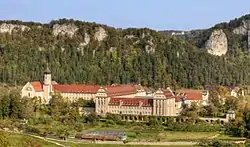Beuron Archabbey
Beuron Archabbey (in German Erzabtei Beuron, otherwise Erzabtei St. Martin; in Latin Archiabbatia Sancti Martini Beuronensis; Swabian: Erzabtei Beira) is a major house of the Benedictine Order located at Beuron in the upper Danube valley in Baden-Württemberg in Germany.
| Beuron Archabbey | |
|---|---|
Erzabtei Beuron | |
 View of the Archabbey in 2009 | |
| Religion | |
| Affiliation | Catholic |
| Sect | Benedictines |
| Location | |
| Location | Beuron |
| Country | Germany |
 Shown within Germany | |
| Geographic coordinates | 48°3′3″N 8°58′9″E |

History
It was founded in 1863 by the brothers Maurus and Placidus Wolter, in buildings which until 1802 had housed an Augustinian monastery. Between 1875 and 1887 because of political conditions during the "Kulturkampf" ("cultural struggle") the monks had to leave the abbey, but used the opportunity to found new communities elsewhere, which afterwards joined together under the leadership of Beuron as the Beuronese Congregation within the Benedictine Confederation.
In the late 19th and early 20th centuries the Beuron Art School, with its emphasis on early Christian and Byzantine art, was influential on religious art of the period. One of the biggest exhibits of this type of art in the United States is at Conception Abbey in Missouri which was founded on principles established by Beuron.
The abbey continues to be a centre of study. The library is the largest monastic library in Germany, with over 400,000 books. Since 1884 the abbey has published the Missale Romanum, a lay missal originally produced by Father Anselm Schott of Beuron. The abbey also houses the Vetus-Latina-Institut (Ancient Latin Institute), which has for its purpose the collection and publication of all extant Old Latin translations of the Bible.
Archabbots since 1863
- Maurus (Rudolf) Wolter from Bonn (1825–1890): Founder prior 1863, Abbot 1868–1890, Archabbot since 1885
- Placidus (Ernst) Wolter from Bonn, the founders brother (1828–1908): 1890–1908
- Ildefons (Friedrich) Schober from Pfullendorf (1849–1918): 1908–1917
- Raphael (Josef) Walzer from Ravensburg (1888–1966): 1918–1937
- Benedikt (Karl Borromäus) Baur from Mengen (1877–1963): 1938–1955
- Benedikt (Johannes) Reetz from Ripsdorf/Eifel (1897–1964): 1957–1964
- Damasus (Josef) Zähringer from Ibach (1899–1977): 1965–1967
- Ursmar (Johannes) Engelmann from Jena (1909–1986): 1970–1980
- Hieronymus (Gerhard) Nitz from Flensburg (1928-2020): 1980–2001
- Theodor (Klaus) Hogg from Kirchen-Hausen (born 1941): 2001–2011
- Tutilo (Heinz) Burger from Löffingen-Seppenhofen (born 1965), since 2011
Burials
- Willibrord Benzler
- Hildebrand de Hemptinne
- Maurus Wolter and all his successors
References
- Gröger, P. Augustinus, OSB, 2005. Das Kloster Beuron; in: Edwin Ernst Weber (ed.): Klöster im Landkreis Sigmaringen in Geschichte und Gegenwart (Heimatkundliche Schriftenreihe des Landkreises Sigmaringen, Band 9), pp. 46–92. Lindenberg: Kunstverlag Josef Fink. ISBN 3-89870-190-5.
- Schaber, P. Johannes, OSB, 2003. Phänomenologie und Mönchtum. Max Scheler, Martin Heidegger, Edith Stein und die Erzabtei Beuron; in: Holger Zaborowski & Stephan Loos (eds.): Leben, Tod und Entscheidung. Studien zur Geistesgeschichte der Weimarer Republik, pp. 71–100. Berlin.
- Stöckle, Joseph, 1888. Das Kloster Beuron im Donauthale (with illustrations and maps). Würzburg & Wien: Leo Woerl's Reisehandbücher.
External links
| Wikimedia Commons has media related to Beuron Archabbey. |
- (in English) Vetus Latina Institute
- (in German) Website of the Erzabtei Beuron
- (in German) Schott Missal
- (in German) Vetus-Latina-Institut
- (in German) and (in Latin) Life stream of the monastic services (high mass with Gregorian chant, Latin vespers, complete and services of the Holy and Easter days)